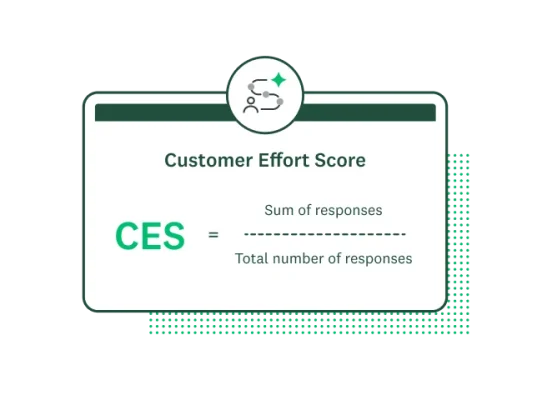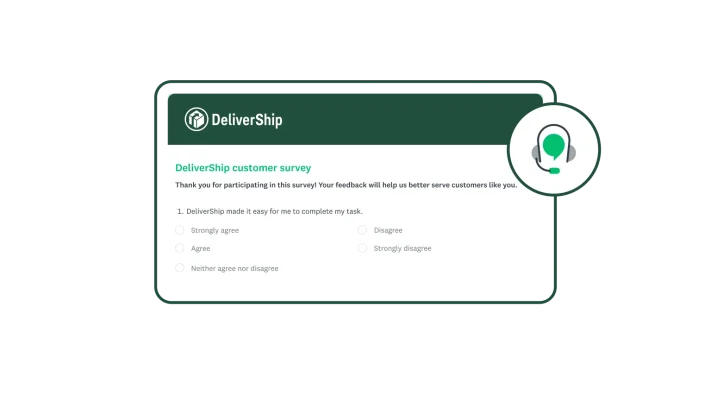Customer Effort Score (CES): What is it and how to use it
Discover why the CES matters and how to effectively calculate and use it to create better customer experiences.

Providing an effortless customer experience (CX) is critical for growing satisfaction, loyalty and referrals. However, organisations can only systematically improve CX by measuring ease and friction at each touchpoint along the customer journey.
What is CES? Definition, importance and survey structure
The Customer Effort Score (CES) measures the relative effort it takes a customer to complete a task or interaction with a company or product. The CES provides a clear insight into how easy it is to interact with your products, services and website. The easier a task is to complete, the less friction a customer feels and the more satisfied they become.
Why is the CES important?
SurveyMonkey research shows that 91% of consumers are likely to recommend a company after a positive, low-effort experience. With that in mind, improving your CES score can drive higher customer satisfaction and improved customer loyalty, as well as word-of-mouth marketing.
How does the CES help your business?
Sending out CES surveys for different stages of the CX process allows you to monitor the customer journey. Your business can use these insights as a catalyst for making enhancements to the customer experience. This process allows you to continually optimise operations that are most prone to friction before customer effort escalates and erodes loyalty.
Structure of a CES survey
A CES survey is usually a short survey with a core customer effort question, plus a few follow-up questions. These follow-up questions allow you to collect some context around the CES question but do not have an impact on your score. Here’s an example of what a CES survey might look like.
Question 1: “To what extent do you agree with the following statement? [Company] makes it easy for me to handle my issue.”
Question 2: “What could we do to make it easier?”
Question 3: “Overall, how satisfied are you with [your company]?”
The history of CES
Development and purpose
A team of researchers at the Corporate Executive Board (CEB) consulting firm first proposed the Customer Effort Score in 2010. The CES was developed to address the hypothesis that the amount of effort required of a customer could have a significant impact on customer satisfaction, loyalty and retention.
The team at CEB posited that exceeding customer expectations wasn’t the most effective way of enhancing customer loyalty. On the contrary, repeated frictionless experiences with a business drive loyalty.
Impact of high-effort interactions
High-effort customer interactions, such as switching channels, repeating information and being transferred to a different support agent, create friction in your customer service process. A SurveyMonkey study found that over a third (35%) of consumers said that being transferred during a CX interaction was one of their top three frustrations.
A customer who repeatedly experiences friction with your business will develop a negative perception of your business, increasing the likelihood of customer churn.
The Customer Effort Score is a response to these findings, allowing businesses to determine which touchpoints could be streamlined.
CES question examples
One of the most effective aspects of the Customer Effort Score is that it’s versatile enough to survey almost any customer touchpoint. By adjusting the CES question, you can gather insights across various processes within your business.
Here are a few CES question examples:
How would you rate the ease of resolving your problem with customer service today?
- Extremely easy
- Very easy
- Somewhat easy
- Not too easy
- Not at all easy
To what extent do you agree with the following statement? {Company} makes it easy to buy a product in the check-out window.
- Strongly agree
- Agree
- Somewhat agree
- Neither agree nor disagree
- Somewhat disagree
- Disagree
- Strongly disagree
Overall, how easy was it to finish onboarding in our software?
- Extremely easy
- Very easy
- Somewhat easy
- Neither easy nor difficult
- Somewhat difficult
- Very difficult
- Extremely difficult
How easy or difficult was it to find the information you were looking for?
- Very easy
- Somewhat easy
- Neither easy nor difficult
- Somewhat difficult
- Very difficult
These questions generate data that you can use to calculate your Customer Effort Score. The survey scale you choose – typically between five and seven points – depends on the specific question and your goals. Each question focuses on different aspects of the customer experience, including support interactions, check-out processes, onboarding and website navigation.
When to use the Customer Effort Score
The Customer Effort Score works best as a way for customers to give your company immediate feedback. It’s likely that asking a customer how their experience was with customer support a month after their interaction would reduce response rates, as customers either won’t remember or won’t care enough to recall.
When to use the Customer Effort Score:
- Immediately after a purchase: After a customer finishes subscribing to a service or buying a product, they can give immediate feedback about how smooth the process was. Streamlining your payment process will help enhance your optimisation rates.
- After a customer support interaction: Your customer support team is the front line of customer care for your business. You need to ensure that customer experiences with your support teams are easy and swift. Use a CES survey to identify areas where your teams could improve.
- When interacting with new product features: When testing a new feature or launching a feature in its beta stage, you can use CES surveys to gather feedback on how easy it is to use. This research feedback will be useful for your user experience team.
How to calculate the CES
The CES calculation is fairly simple. To calculate CES, take the total sum of all of your responses and then divide by the number of total responses.

Let’s suppose that 100 people replied to your CES survey. They could have selected an answer on a scale of 1–7. The total sum of all responses came to 450. By dividing 450 by 100, we get a final CES score of 4.5. This means that on a scale of 1–7, your average CES is 4.5.
Now that you understand how to measure customer effort scores, let’s explore what a good, average and bad score looks like.
What is a good Customer Effort Score?
Unlike a Net Promoter® Score (NPS®) survey, there is no universally standardised benchmark for the Customer Effort Score (CES), due to varying response scales used by different companies.
For instance:
- A CES score of 6 on a scale of 1–7 is considered excellent.
- CES scores below 4 on a 1–7 scale suggest significant room for improvement in your processes.
As a general guideline, aiming for the top 20% of your chosen scale is advisable. On a scale of 1–7, this translates to a score of 5.6 and above, which indicates a good CES.
Monitoring your CES score over time and benchmarking against industry standards can provide valuable insights into customer satisfaction and areas needing attention.
Benefits of the Customer Effort Score
Your Customer Effort Score places a quantifiable value on how much effort your customer exerts when interacting with your business.
By monitoring your CES over time and implementing changes to streamline your customer experience, your customers will feel less frustrated with your brand.
With less frustration comes:
- Increased customer loyalty
- Decreased churn
- More frequent positive recommendations
Let’s break down these benefits of CES further.
Improved customer satisfaction and loyalty
Customer experience (CX) shapes overall satisfaction with your business, which directly feeds customer loyalty. By using the insights from Customer Effort Scores to remove obstacles, you can build a more frictionless customer journey that delights.
Running a robust customer feedback programme centred around CES provides the insights necessary to guide business improvements that make an impact.
When you include CES in a Voice of the Customer (VoC) programme, you’re creating a built-in feedback loop that can accelerate support solutions and optimise processes.
Reduced customer churn and increased customer retention
Satisfied customers naturally repurchase, renew contracts and refer others to your business. The opposite also holds true: disappointed customers abandon brands that test their patience.
Customer retention depends on the cumulative trust formed through friction-free journeys.
According to recent research, 59% of consumers who trust a brand are more likely to buy a new product that the business introduces and 67% are more likely to stay loyal and recommend it to others.
By addressing pain points and making processes more customer-friendly, businesses can create an environment that encourages customers to continue their relationship with your business.
When channelled proactively, CES insights help organisations build customer trust and retention by eliminating unnecessary burdens at the outset to avoid the need for costly post-churn corrections.
Enhanced word-of-mouth recommendations and customer advocacy
Customers who love your brand often become your biggest supporters. They are more likely to buy from your business repeatedly and recommend your business to family and friends.
Consumers are likely to trust recommendations from people they know more than any other marketing channel. This rings especially true if your business doesn’t have a recognisable brand name.
By remedying customer pain points swiftly, you’ll create brand loyalty that can translate into word-of-mouth recommendations.
How to use the customer effort score
Your business should use its CES to find opportunities for improvement. By making small improvements to each customer touchpoint, you provide the best customer service and experience possible.
Here are some steps to follow when using the CES metric.
Step 1: Set objectives for your CES survey
To effectively create CES surveys, your business should identify customer pain points in their journey. Your main goal will be streamlining the customer’s process of interacting with your business. To do this, you need to understand where these connection points occur.
From there, you can set clear objectives for your survey, such as determining the CES during or after different customer touchpoints, evaluating the causes of a low CES and mitigating them in the future.
Step 2: Ask the right CES question
Your business can format the customer effort question as a simple multiple choice question. We also recommend asking a follow-up, open-ended question that asks a customer why they gave that rating.
For example:

From there, you can ask a follow-up question, such as:

Step 3: Choose the right method to send your CES
When you decide it’s time to send the survey, you have several options to choose from. A customer support rep can share a link to the survey, or you can send it to several customers at the same time via email or embed it on your website.
It’s a good idea to keep the survey short and sweet. Asking too many questions could result in a customer clicking away from your survey before responding. Our two expertly written CES questions work wonders and can be found in our Customer Effort Score survey template.
Step 4: Send CES surveys at the right time
You may be wondering when the optimal time is to assess customer scores during the customer management process. The best practice is to measure them frequently across the customer journey rather than just once.
The best way to pinpoint any obstacles in the customer experience is to ask customer effort questions at various points of engagement. Try to ask customer effort questions immediately after these events to collect timely, actionable feedback.
Here are some customer touchpoints to monitor with CES:
- After interacting with customer support
- Immediately after users have completed a purchase
- During the onboarding process
- At various points while browsing the site (e.g. reading a help centre article)
- After basket abandonment
These will help you to gain a comprehensive understanding of how your company supports your customers throughout various parts of their journey.
Step 5: Act on customer feedback
One of the most important aspects of utilising a CES is to improve customer-facing processes. Start by looking at low numbers, reading carefully through their explanations. If you notice recurring friction areas, you have a clear objective to improve and implement change.
Over time, this strategy will help remedy negative experiences with your business, boosting your CES.
Related reading: The ultimate guide to running a customer feedback programme.
Step 6: Bolster customer service training
Customer feedback unlocks the ability to identify areas where your customer service team may be underperforming.
For example, a common complaint for many businesses is that customer support takes too long to solve a customer’s problem. To remedy this, you could introduce more customer service training modules for your team to improve their skills and find solutions more rapidly.
Another solution may be to introduce response time limits to your customer service team. This could also indicate that you should hire one or two more customer support agents to reduce response time.
Step 7: Optimise and improve
Send out Customer Effort Score surveys regularly throughout the customer journey to create a steady stream of actionable CES data for optimising touchpoints. This approach allows you to incrementally enhance processes over time.
As your organisation makes ongoing improvements guided by CES insights, you’ll begin to see this metric improve. In parallel with this increase in CES, you will notice the previously mentioned benefits, such as higher customer satisfaction and reduced customer churn.
When to use a CES, NPS and CSAT
While CES provides key insights into the ease of customer interactions, two other vital metrics should be on your radar: Net Promoter Score (NPS) and Customer Satisfaction (CSAT) Score. Each measurement lens offers distinct yet complementary value.
Here’s what each of these customer experience metrics measures:
- CES: CES measures the ease with which a customer completes a task, monitoring interaction friction.
- NPS: NPS measures a customer’s overall satisfaction with your business as a whole.
- CSAT: CSAT measures a customer’s satisfaction related to specific services and products.
Let’s explore when to best use each of these metrics to measure customer experience.
Customer Effort Score (CES)
As discussed previously, CES is best used to measure customer effort. It explores how easy you make the act of solving problems, purchasing products and interacting with your business. A CES primarily focuses on minimising customer effort and maximising customer satisfaction.
Net Promoter Score (NPS)
A Net Promoter Score survey evaluates customer loyalty to a brand. Businesses can track this metric by enquiring about the likelihood of customers recommending your brand, products or services to others.
Beyond this, NPS helps distinguish between loyal brand advocates and customers who may switch to competitors.
Related reading: How to use NPS surveys to create the best customer experience.
Customer Satisfaction (CSAT) Score
CSAT measures customer satisfaction by seeking customers’ overall ratings of your business, an interaction, or a product or service.
This score helps you evaluate and improve individual touchpoints across the customer journey. Targeting one touchpoint per assessment and monitoring advancements within that area will ensure that you’re maximising the value of CSAT.
Related reading: The ultimate guide to the Customer Satisfaction Score.
Reduce customer effort with SurveyMonkey
Simply measuring your Customer Effort Score provides limited value without commitment to act. For transformational change, you need to close the loop between assessing journey pain points and address those areas using better-designed processes.
The key is applying the CES operationally, creating a steady cadence to gather and analyse customer feedback. Only then can you implement changes and optimise the customer experience when it’s needed the most.
Streamline your customer experience by getting started with the SurveyMonkey CES template.
Learn more about how SurveyMonkey can help to improve your customer experience today.
NPS, Net Promoter and Net Promoter Score are registered trademarks of Satmetrix Systems, Inc., Bain & Company and Fred Reichheld.
Discover more resources

Customer satisfaction survey templates
Explore our customer satisfaction survey templates to rapidly collect data, identify pain points and improve your customer experience.

See how Ryanair collects customer insights at scale
Discover how Ryanair uses SurveyMonkey and its Microsoft Power BI integration to track 500k monthly CSAT surveys and improve customer experiences.

How to identify customer needs
Refine your market research approach with our guide to identifying customer needs and what UK shoppers are looking for in 2024.

See how woom enhances its employee and customer experience
Discover how woom uses SurveyMonkey to launch multilingual surveys at scale, improve the employee experience and capture customer insights.